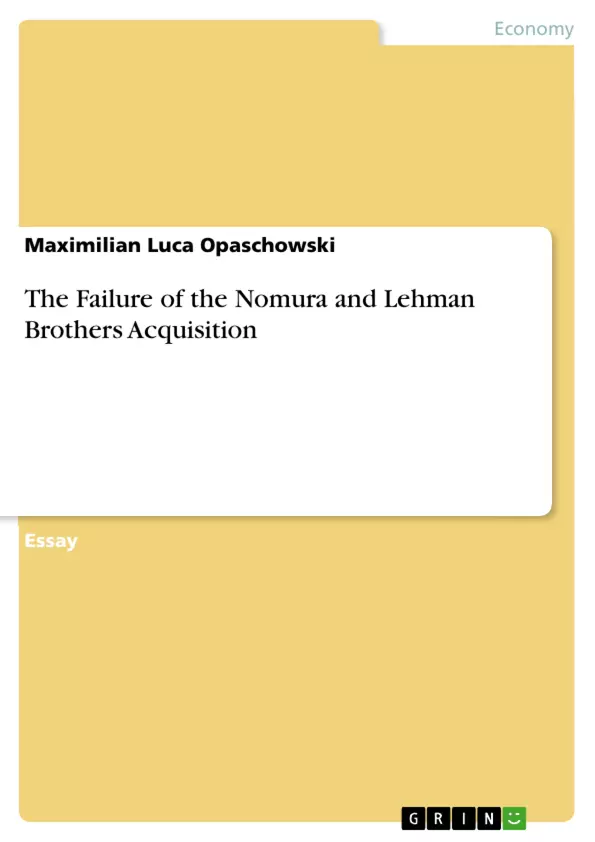The Lehman Brothers Holdings Inc. was a former global financial services firm, which worldwide headquarters were located in New York City, United States. Through its subsidiaries the firm provided its services to governments, corporations, institutions and individuals.
On September 22 in 2008, after it collapsed because of bankruptcy, the CEO of Nomura Holdings Inc. announced the acquisition of Lehman Brothers’ Asia-Pacific, later also European and Middle-East branches. Nomura is a leading Japanese financial holding company with headquarters in Tokyo, Japan. Like Lehman Brothers it provides various financial services worldwide.
Table of Contents
- Introduction
- The Acquisition
- Reasons for Failure
- Communication Issues
- Cultural Differences in Workplace Practices
- Differing Business Attitudes and Behaviors
- Analysis of Contributing Factors
- Conclusion (Not Included in Preview)
Objectives and Key Themes
This paper analyzes the failed acquisition of Lehman Brothers' non-US branches by Nomura Holdings Inc. in 2008. It aims to identify the key factors contributing to the acquisition's failure, examining various perspectives and expert opinions.
- Cross-cultural communication barriers
- Clashing corporate cultures and business practices
- Impact of differing national and organizational values
- The role of language proficiency in international mergers and acquisitions
- Workplace dynamics and integration challenges
Chapter Summaries
Introduction: This introductory section sets the stage by presenting the context of the Lehman Brothers collapse and Nomura's subsequent acquisition of its non-US assets. It introduces the key players and the initial optimism surrounding the deal, contrasting it with the later concerns and eventual failure. The section highlights the significant cultural differences between the Japanese and American/European corporate environments, foreshadowing the central conflict of the analysis.
The Acquisition: This chapter details the acquisition process itself, focusing on the swiftness of the deal and the initial high hopes held by both Nomura and the acquired Lehman Brothers employees. The chapter establishes the initial motivations for Nomura – namely, global expansion and the acquisition of valuable expertise. The narrative subtly lays the groundwork for the later discussion of the failure by emphasizing the seemingly ideal circumstances of the acquisition.
Reasons for Failure: This section delves into the multifaceted reasons for the acquisition's failure. It analyzes the perspectives of various experts, highlighting the crucial role of communication problems stemming from linguistic and cultural differences. The chapter also explores the clash between Nomura's hierarchical and conservative corporate culture and Lehman Brothers' more aggressive, risk-tolerant approach. This section serves as the core of the analysis, presenting diverse viewpoints and laying the foundation for further discussion.
Analysis of Contributing Factors: This section analyzes in detail the three main contributing factors to the acquisition failure: communication issues, cultural differences in workplace practices, and differing business attitudes and behaviors. It further explores the implications of each factor and its effect on the overall outcome. This chapter synthesizes the perspectives of multiple experts (Nakamoto, Tudor, Choi), highlighting the interconnectedness of the various problems encountered.
Keywords
Cross-cultural communication, international mergers and acquisitions, corporate culture clash, Nomura Holdings Inc., Lehman Brothers Holdings Inc., cultural integration, linguistic barriers, business attitudes, workplace practices, organizational values, communication failures.
Lehman Brothers/Nomura Acquisition Failure: Frequently Asked Questions
What is this document about?
This document is a preview of a paper analyzing the failed acquisition of Lehman Brothers' non-US branches by Nomura Holdings Inc. in 2008. It explores the key reasons for the failure, focusing on cross-cultural communication barriers, clashing corporate cultures, and differing business attitudes.
What are the main objectives of the paper?
The paper aims to identify and analyze the key factors contributing to the acquisition's failure. It examines various perspectives and expert opinions to understand the complexities of the situation.
What are the key themes explored in the paper?
Key themes include cross-cultural communication barriers, clashing corporate cultures and business practices, the impact of differing national and organizational values, the role of language proficiency in international mergers and acquisitions, and workplace dynamics and integration challenges.
What are the chapters included in the preview?
The preview includes an introduction, a chapter detailing the acquisition process, a chapter analyzing the reasons for failure, and a chapter analyzing contributing factors. The conclusion is not included.
What does the Introduction chapter cover?
The introduction sets the context of Lehman Brothers' collapse and Nomura's acquisition, introduces key players, and highlights the initial optimism contrasted with the eventual failure. It emphasizes the significant cultural differences between the Japanese and American/European corporate environments.
What does the "The Acquisition" chapter cover?
This chapter details the acquisition process, focusing on its speed and initial high hopes. It establishes Nomura's motivations – global expansion and acquiring expertise – subtly laying groundwork for the later discussion of the failure.
What does the "Reasons for Failure" chapter cover?
This chapter delves into the multifaceted reasons for failure, analyzing expert perspectives and highlighting communication problems stemming from linguistic and cultural differences. It also explores the clash between Nomura's and Lehman Brothers' corporate cultures.
What does the "Analysis of Contributing Factors" chapter cover?
This chapter analyzes three main contributing factors: communication issues, cultural differences in workplace practices, and differing business attitudes and behaviors. It explores the implications of each factor and their interconnectedness, referencing experts like Nakamoto, Tudor, and Choi.
What are the key words associated with this analysis?
Key words include cross-cultural communication, international mergers and acquisitions, corporate culture clash, Nomura Holdings Inc., Lehman Brothers Holdings Inc., cultural integration, linguistic barriers, business attitudes, workplace practices, organizational values, and communication failures.
What is the overall takeaway from this preview?
The preview suggests that the failure of the Nomura-Lehman Brothers acquisition was a complex event resulting from a confluence of factors, primarily rooted in significant cultural and communication differences between the two organizations.
- Quote paper
- Maximilian Luca Opaschowski (Author), 2017, The Failure of the Nomura and Lehman Brothers Acquisition, Munich, GRIN Verlag, https://www.grin.com/document/469309



